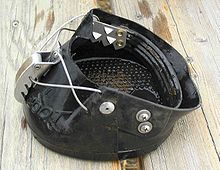Hoof shoe
A hoof shoe is a hoof protection that is not permanently connected to the hoof. The hoof shoe is pulled over a horse's hoof and attached. As a rule, hoof boots are made from various plastics and / or polymers.
application
Hoof boots are used for hooves that, for reasons of illness, cannot be shod with traditionally nailed or glued-on horseshoe , because hoof protection is only required temporarily, e.g. B. Trail rides with changing surfaces or riding on hard ground, or the horse is switched to natural barefoot.
The use of hoof boots makes sense for horses with laminitis . With very sensitive hooves, the hoof shoe can be left on the hoof for several days. Conventional horseshoeing affects the horse's hoof mechanism too much, especially deer horses. However, not all types of hoof boots are suitable for these purposes. There are special therapeutic hoof shoes to support laminitis.
At hoof be fixed either by hoof boots buckles, clips or Velcro straps that press the shoe to the hoof. There are also hoof boots with straps or gaiters that are attached to the horse's ankle. There are variants that have an internally built-in air chamber system that uses an air pump to inflate the worn shoe and thus press it onto the hoof. There are hoof shoes made of machinable PU plastic that must be individually adapted to the shape of the hoof before they are used for the first time. In general, modern hoof boots are easy to handle, but should be tried on (not adjusted!) Or selected by a hoof trimmer or blacksmith, as a good fit is important. The hoof shoe has to fit, in no case should the hoof fit the shoe. Since, depending on the surface, the penetration of dirt, sand or mud cannot be prevented, you may have to check and clean the hoof boots during a ride to avoid chafing.
Other uses
The term claw or bone shoe means animal orthopedic aid for the worldwide problem of removing horn damage (injuries) to claws . A bone or cattle shoe is suitable for cattle husbandry with high stress on hard ground, such as very hard stable floors, with claw rot , crooked toes, damage due to natural deformities, cuts in the sole due to sharp stones, etc. Attaching hoof shoes or cattle shoes (today mostly made of plastic) reduces the penetration of dirt and bacteria and prevents infectious diseases of the hooves of all types of ungulates . When attaching hoof boots in cattle and generally in perissodactyls the expert speaks of claw shoes as animal orthopedic help for injured hooves.
history
Hoof shoes, so-called hipposandals, were, in contrast to horseshoes, already known in ancient times. There are archaeological finds from the Battle of the Harzhorn , which prove the Roman origin of the hipposandals. They were probably used for riding on the paved Roman roads or in cities and were rather unsuitable for higher gaits. In historical times, such hoof boots were mainly put on with corpses. In Roman times, the biographer Suetonius (1st / 2nd century AD) reports how the carter of Emperor Vespasian put on such hipposandals to the mules during a trip to protect the heavily used hooves.
Web links
- Roman battle on the Harzhorn
- Course offerings Natural Hoofcare - Das Barhuf-Institut
- Courses offered by Strohm Farriery
- Further training for veterinarians for horses at the Veterinary Faculty of the University of Leipzig
literature
- Uwe Lukas: Healthy hooves - no coincidence !, Chapter 4, p. 58 ff, 1st edition 2007, FN-Verlag, ISBN 978-3-88542-475-8
- Key data horse, volume 2: Health, p. 33 ff, 1st edition 2005, Federal Ministry for Food, Agriculture and Consumer Protection, ISBN 978-3-88542-479-6
Individual evidence
- ↑ Planet Wissen: From Hipposandals, Battlefields and Gladiators - The Romans in Germany, broadcast on May 26, 2011 (SWR, WDR, BR-alpha)
- ^ Suetonius: Vespasian. Extensive ancient biography from the collection of the emperor's biographies from Caesar to Domitian. Numerous editions, for example with a German translation in: Gaius Suetonius Tranquillus: All preserved works. Magnus, Essen 2004, ISBN 3-88400-071-3 (Latin text, English translation)



